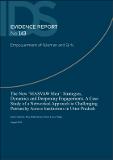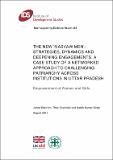| dc.contributor.author | Edström, J | |
| dc.contributor.author | Shahrokh, T | |
| dc.contributor.author | Singh, S.K. | |
| dc.coverage.spatial | India | en |
| dc.date.accessioned | 2015-08-14T13:51:05Z | |
| dc.date.available | 2015-08-14T13:51:05Z | |
| dc.date.issued | 2015-08 | |
| dc.identifier.citation | Edström, J.;Shahrokh, T. and Singh, S.K. (2015) The New ‘MASVAW Men’: Strategies, Dynamics and Deepening Engagements. A Case Study of a Networked Approach to Challenging Patriarchy Across Institutions in Uttar Pradesh, IDS Evidence Report 143, Brighton: IDS | en |
| dc.identifier.uri | https://opendocs.ids.ac.uk/opendocs/handle/20.500.12413/6757 | |
| dc.description.abstract | Uttar Pradesh is ranked second among Indian states in ‘crimes against women’, which includes rape, abduction, dowry-related deaths, mental and physical torture and sexual harassment (Government of Uttar Pradesh 2006: 130). The majority of such crimes against women are committed by family members, but this gendered violence and inequality also permeates the broader economy, systems and structures that govern everyday life. During the past 10–15 years, the issue of gender equality has been raised by civil society and government, and there have been some positive changes too. Yet, there is increasing fear among some men about decreasing opportunities as a result of women’s empowerment, reflected in the evolution of ‘men’s rights’ organisations, with anti-feminist agendas (Chowdhury 2014). Bucking this trend, since 2002, a growing group of men have built an engagement for addressing gender-based violence (GBV), in Men’s Action to Stop Violence Against Women, or MASVAW. This case study explores the role of men and boys in addressing sexual and gender-based violence through collective action; a collaboration between the Centre for Health and Social Justice in New Delhi, the network MASVAW in Uttar Pradesh, and the Institute of Development Studies in the United Kingdom. This partnership grew in an attempt to problematise and politicise the way the terms of the debate were being set in the broader field of engaging men in addressing GBV in the development field. | en |
| dc.description.sponsorship | UK Department for International Development | en |
| dc.language.iso | en | en |
| dc.publisher | IDS | en |
| dc.relation.ispartofseries | IDS Evidence Report;143 | |
| dc.relation.ispartofseries | IDS Evidence Report Brief;143 | |
| dc.rights.uri | http://creativecommons.org/licenses/by/3.0/ | en |
| dc.subject | Gender | en |
| dc.title | The New ‘MASVAW Men’: Strategies, Dynamics and Deepening Engagements. A Case Study of a Networked Approach to Challenging Patriarchy Across Institutions in Uttar Pradesh | en |
| dc.type | IDS Evidence Report | en |
| dc.rights.holder | IDS | en |
| dc.identifier.ag | OT/11009/3/3/2/114 | |
| dc.identifier.ag | OT/11009/3/3/2/115 | |



